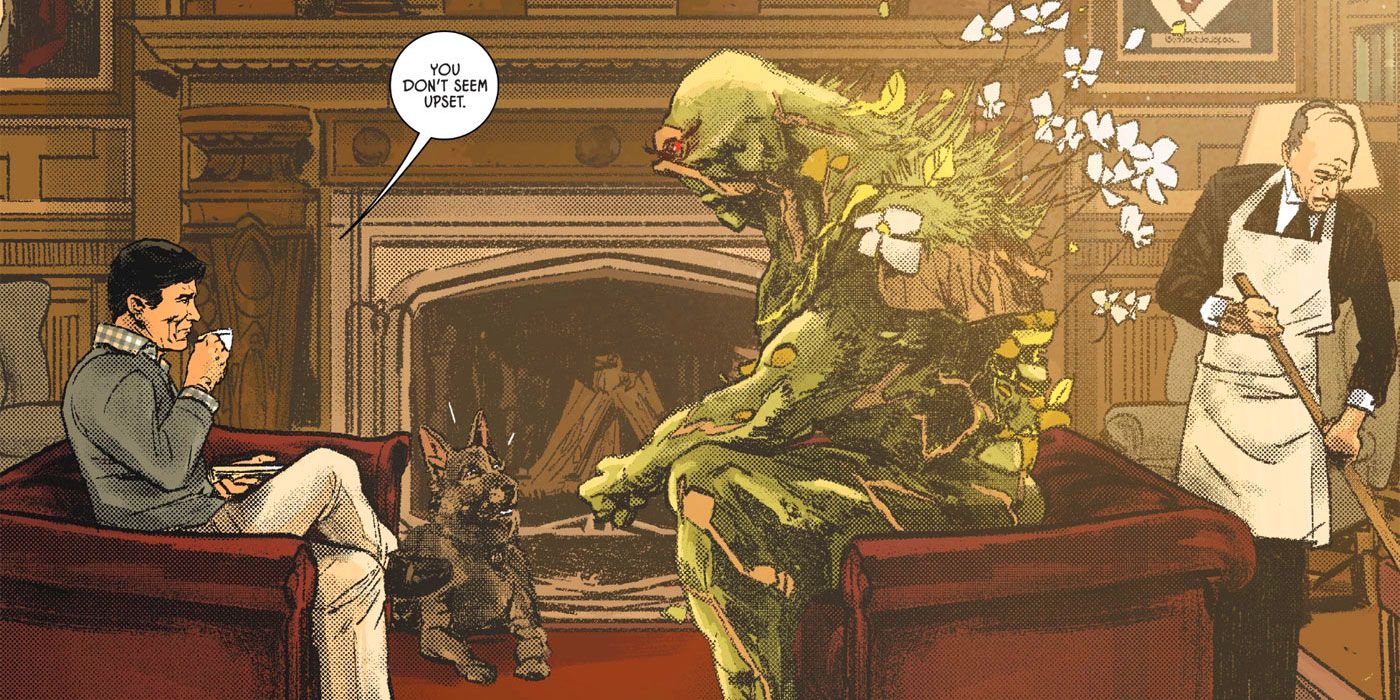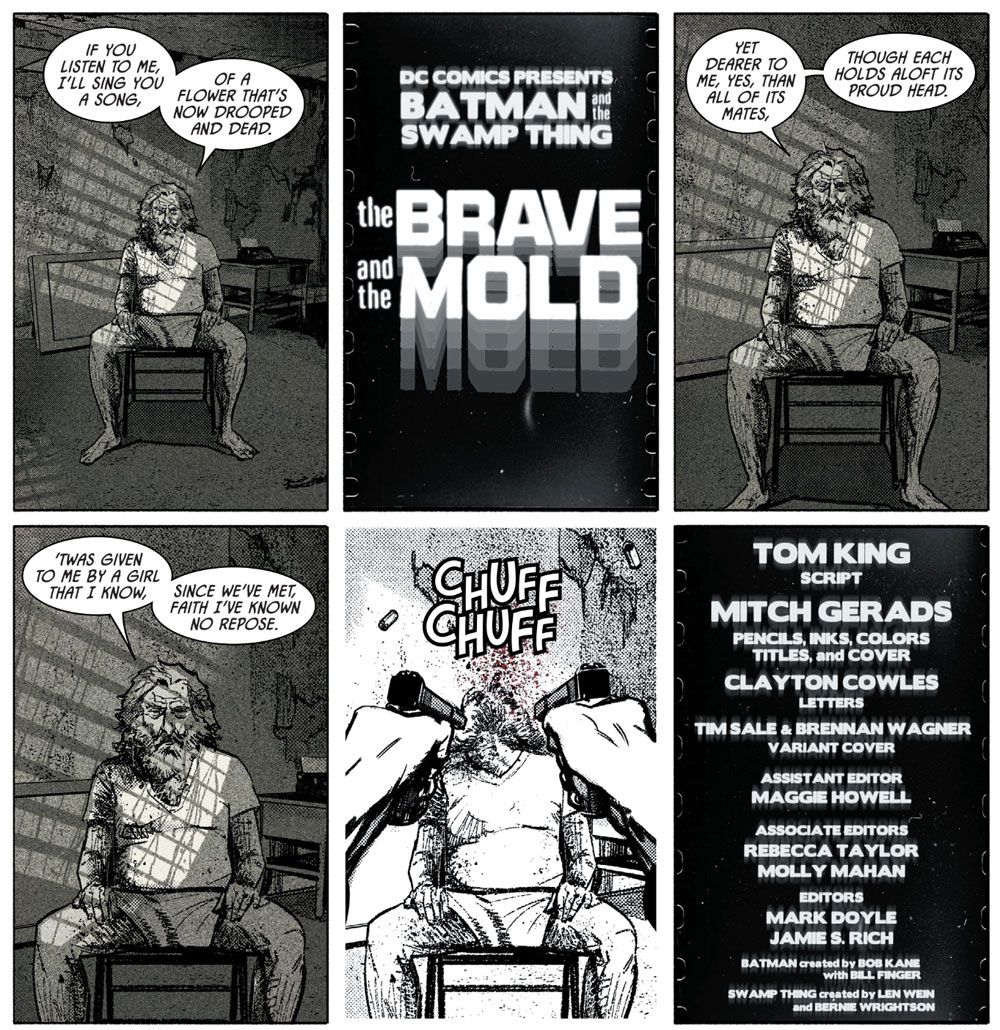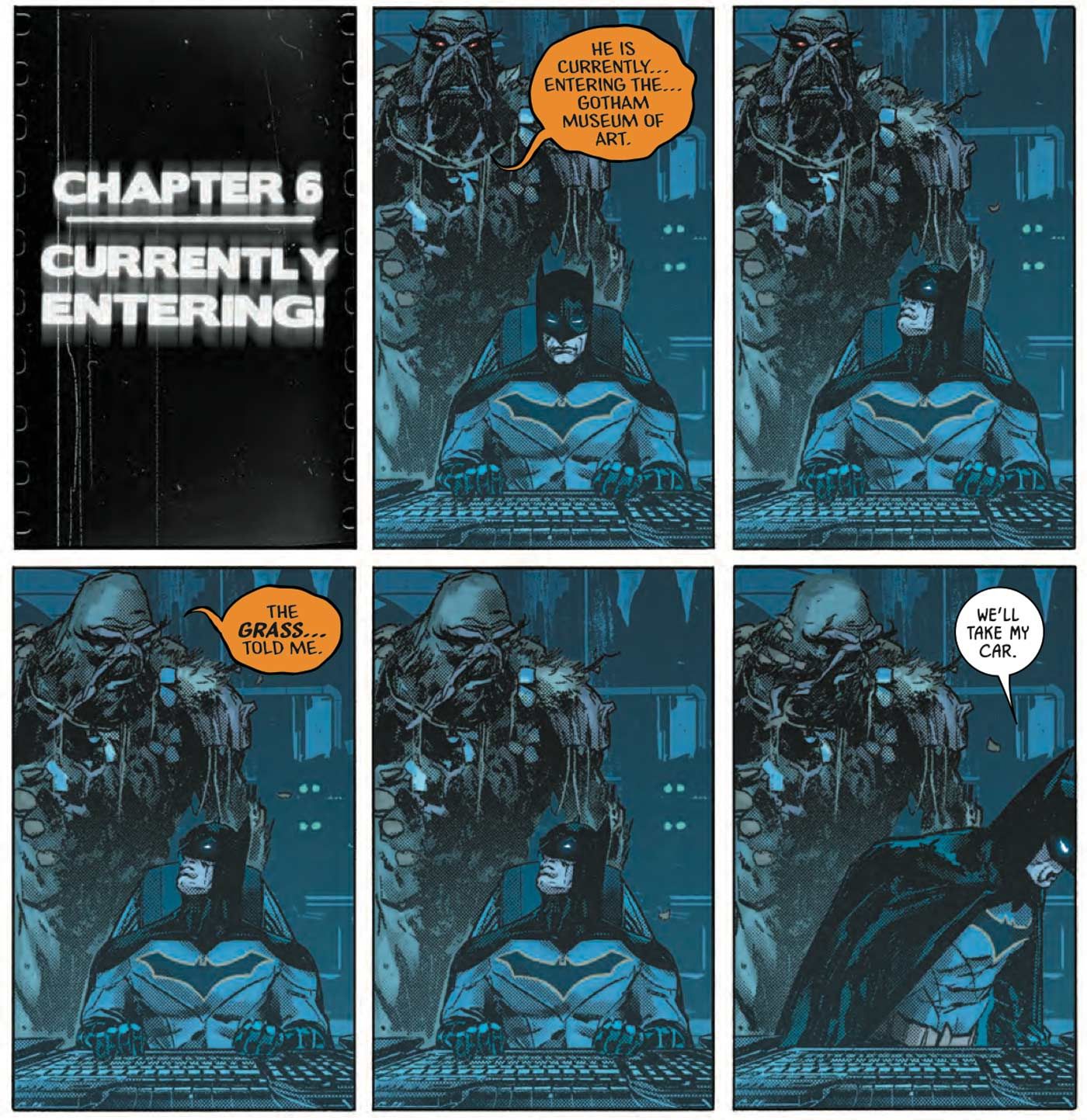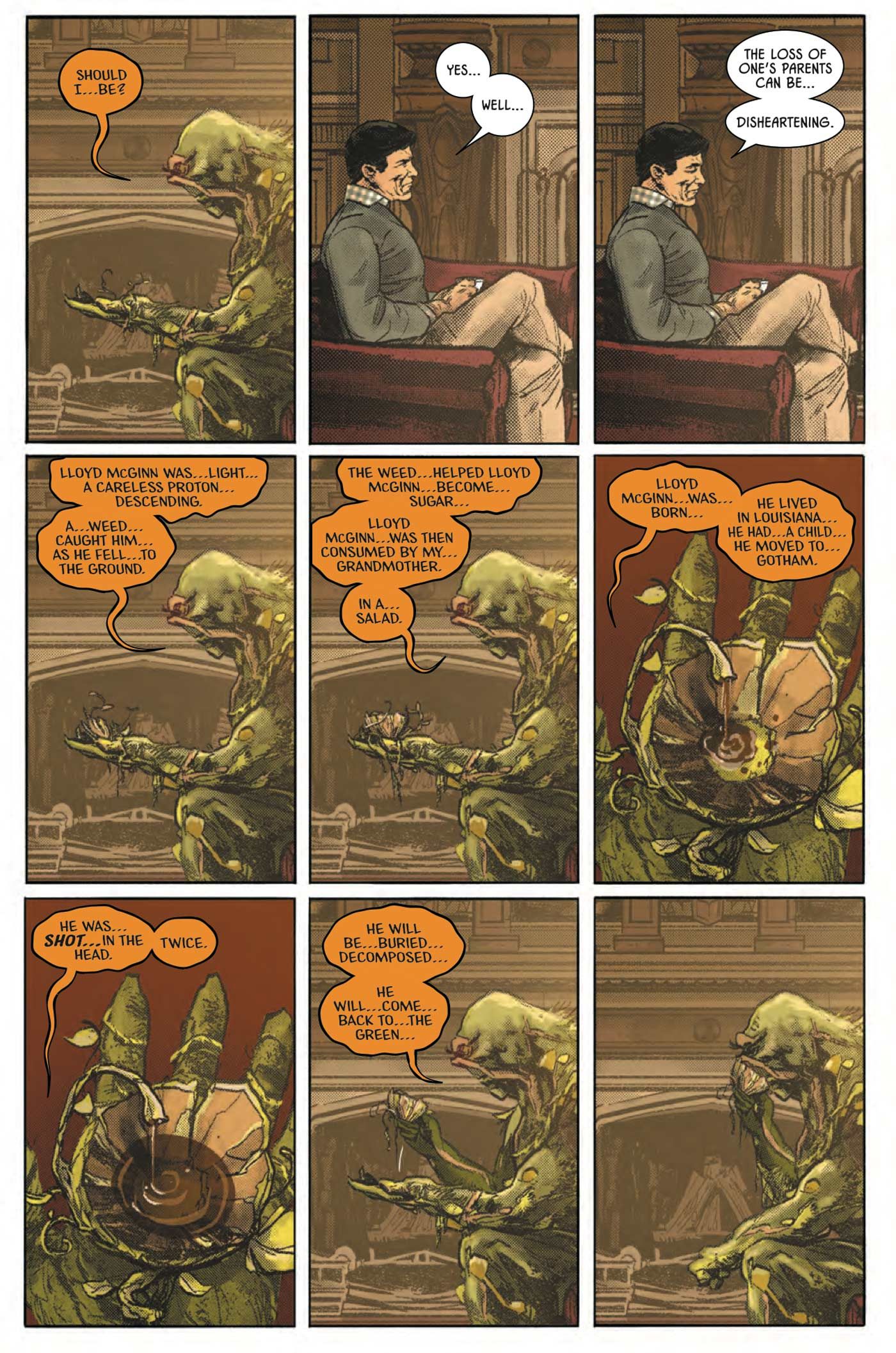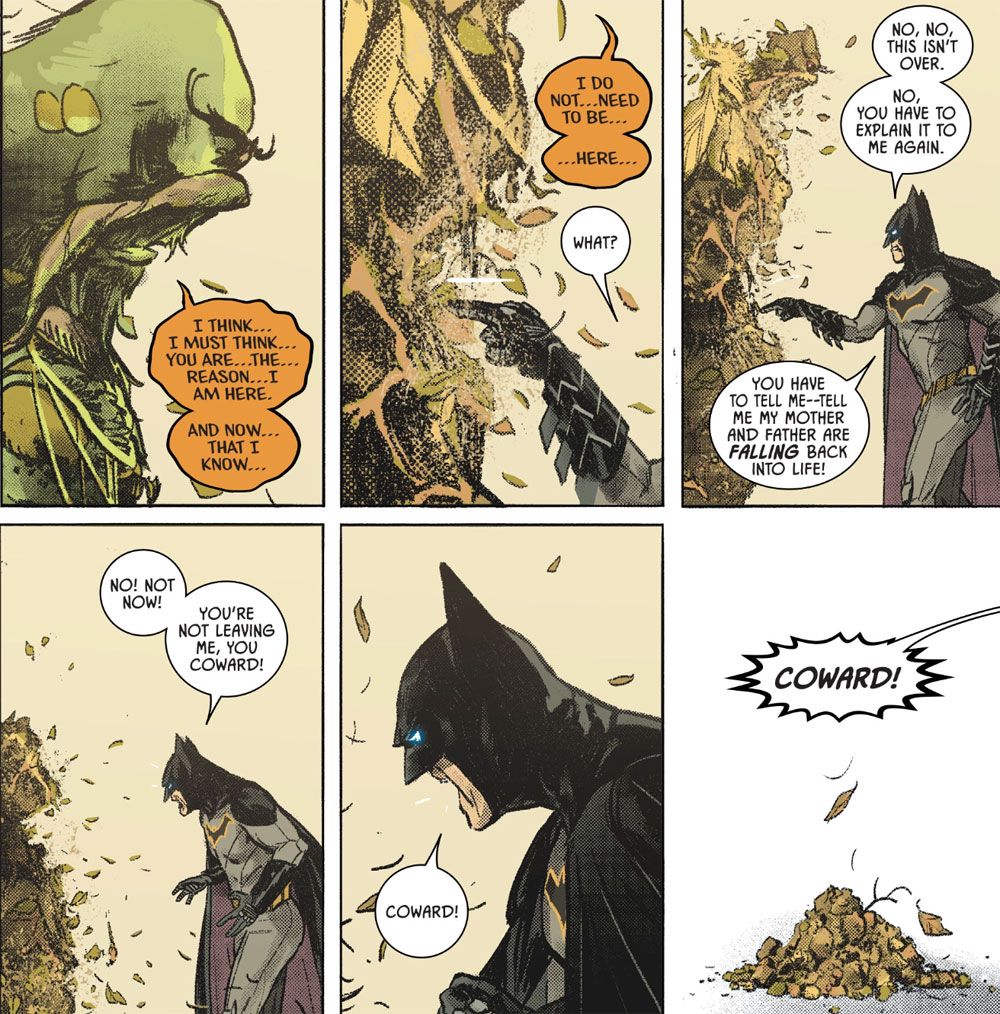SPOILER WARNING: The following article contains major spoilers for Batman #23, by Tom King and Mitch Gerads, and on sale now.
“If you listen to me, I’ll sing you a song of a flower that’s now drooped and dead,” begins Tom King and Mitch Gerads’ Batman #23. The singer is a bearded old man, an anonymous stranger, who is dead four panels later, shot in the head with twin pistols by an invisible assailant.
The song is My Wild Irish Rose, by the Irish-American tenor, Chauncey Olcott, who also composed the better known When Irish Eyes are Smiling. The lyrics are a clue to the identity of the victim. Sixty-eight year-old Lloyd Bernard McGinn, who hails from Louisiana, is the biological father of Swamp Thing Alec Holland, who enlists Batman to help him find the murderer.
The issue's story title, "The Brave and the Mold," is a pun on DC’s long-running The Brave and the Bold series, which debuted in 1955 as an anthology series of adventure comics for heroes from the past, like Robin Hood and the Golden Viking. It eventually became a Batman team-up book in the wake of the popular 1966 television series starring Adam West. Among the title’s many historic moments are the first appearance of the original Suicide Squad, as that of Neal Adam’s iconic take on Batman.
INTERVIEW: King & Gerads Deliver a Miracle with Swamp Thing-Infused Batman #22
This isn't the first time Batman and Swamp Thing have worked together; the pair teamed up in the pages of 1975’s The Brave and the Bold #122. Written by Bob Haney, and drawn by Jim Aparo, that story featured Batman rescuing the creature from malevolent carnival owner B.B. Rigg, then teaming up to save Gotham City from a giant root that is invading it, and which is wrongly believed to be the work of Swamp Thing. As the government prepares to dust the city with the chemical “Crimson 13,” Alec Holland seemingly dies, pulling up the king root, but is revived when Batman returns his remains to the bog.
Unlike its 1970s predecessor, "The Brave and the Mold" is not a tale of saving the city, but a straight up police procedural, with a decidedly noir tone. King and Gerads heighten the hardboiled nature of the story—which shows the Dark Knight shaking up the denizens of Gotham’s underground as he searches for clues—by dividing the issue into chapters, which are separated by black and white title cards on scratched and stuttering film stock. This visual flourish is also a tribute that 1970s team-up, as one of the hallmark on Haney and Aparo’s run on The Brave and the Bold was the division of every self-contained story within an issue into parts.
The pair also provide a solid dose of horror. There are also several moments of levity, including some hilarious banter that falls squarely into the buddy action comedy school of dialogue.
Although "The Brave and the Mold" is a stand-alone story, it functions a coda of sorts to "The Button," which concludes with this week's The Flash #22. It also builds on King’s "I am Suicide" arc, which revealed that Bruce Wayne attempted to kill himself at age 10, and that becoming Batman was not so much a matter of vengeance, as it was a prolonged act of self-negation driven by an unrelenting death wish.
The search for Holland’s father’s murderer is not just another investigation for the Dark Knight, but it is also a way to deal with the loss of his own parents, and the recent trauma of seeing his father die again. As they travelled through Hypertime in Batman #21, Bruce and the Flash (Barry Allen) encountered the Flashpoint version of Thomas Wayne, who had survived the murder of his wife and son to become Batman. As he prepared to face annihilation at the hands of the armies of Aquaman and Wonder Woman, the elder Wayne blinked out of existence as his timeline disappeared.
Before he faded out forever, Thomas begged his son to abandon his fate as a vigilante. “Don’t be Batman,” he implored. “Find happiness, please. You don't have to do this for me. Don’t do it for your mother. Be a father for your son in a way I never could.”
As Batman moves in on the killer in "The Brave and the Mold," he is impressed by Swamp Thing’s sense of calm. As Bruce sips tea in a Wayne Manor sitting room, and Alfred cleans up the trail of dirt and organic detritus left behind by the bog dwelling visitor, he remarks, “You don’t seem upset.” Swamp Thing muses on the cycle of life, death and decomposition. “He will come back in the Green,” the creature replies.
The answer resonates with Batman, who has been recast as a nihilist by King, and who has lost his father twice, now. Perhaps he can find a meaning in his parent’s death that will move him beyond a path of self-destruction. Maybe there’s something in the way that Holland is handling the death of his father that will enable Wayne to finally come to terms with his own loss.
Another crucial element in this story is the fact that Wayne and McGinn both left letters for their sons. The resolution of the story -- and its potential for closure -- hinges on the way that Bruce and Alec respectively handled the correspondence from their absent fathers.
Although it is self-contained, "The Brave and the Mold" is not without consequences, and is extremely important to King's over-arching Batman story. Like the "I am Suicide" arc, it refines and redefines the emotional core that constitutes Batman. It not only asks what it means to be an orphaned son, but also what it means to be a father. It also leaves the reader wondering whether Batman’s final shocked admonishment hurled at Swamp Thing equally applies to himself.
King and Gerads have stated that this one-shot will have long-term repercussions, and an impact upon Batman stories yet to come. Perhaps Bruce Wayne will finally stop trying to die in order to honor his parents, and instead start living in order to honor his son.

